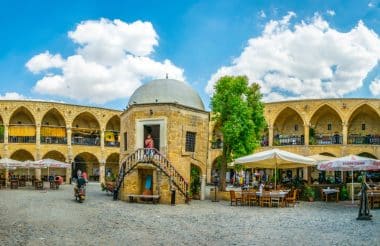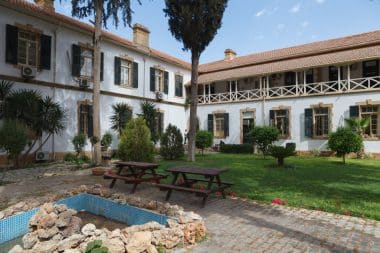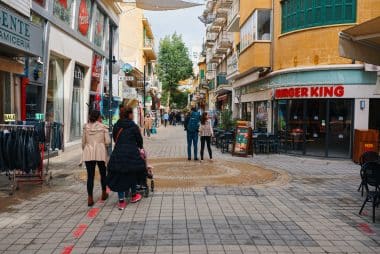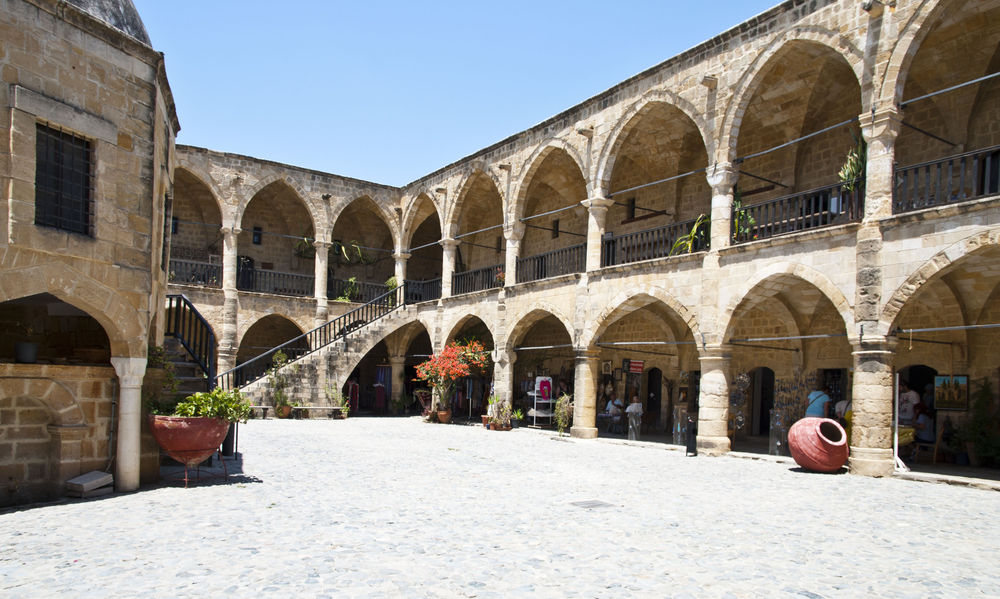Nicosia is a city divided into two parts and is located in the heart of the island of Cyprus in the eastern Mediterranean. Nicosia is the capital of the island. Under international law, it is also completely part of the Republic of Cyprus. However, since 1983 the northern part has been under the administration of the internationally unrecognized Turkish Republic of Northern Cyprus.

The border between the southern part and the Turkish northern part runs through the historic old town. If you want to move from one part of the city to another, you will need an identity card or passport, which must be presented to the border authorities. Pedestrians can use various border crossings in Nicosia.
A crossing is located directly in the pedestrian zone “Ledra Street” in the old town. About 500 meters from Old Nicosia, there is another border crossing at the former “Ledra Palace Hotel”. In the northern part of Turkey, a stay of between 30 and 90 days is permitted. Nicosia is a popular destination on both sides and is particularly interesting and rich in contrasts with its Turkish, Greek and international influences. Go on a journey of discovery and let yourself be surprised!
Enjoy oriental flair in the Turkish northern part of Nicosia

The largest city in Northern Cyprus is North Nicosia with around 75,000 inhabitants. This is where the administrative center and the seat of government of the country are located. Regardless of the political situation, there is a lot to see in the northern part of the city. The heart of the northern Cypriot old town is the “Atatkürk Square” with its Venetian granite column. Numerous street cafés and taverns line the “Atatürk Square” and invite you to linger. Among the most interesting sights in northern Nicosia are the historical monuments. In the “Caravanserai Büyük Han”, the oriental atmosphere can be felt on every corner.
The complex, which was built in the 16th century, impresses with a picturesque courtyard and the pretty mosque with a white dome. In the caravanserais, merchants and travellers used to take a break with their animals and also used the opportunity to trade their goods. Even today, traditional products, books and art objects can be purchased here. A visitor magnet in the Turkish part is also the “Selimiye Mosque”. It was built as the “Sophia Cathedral” in the period from 1209 to 1326.
A fountain to wash before prayer stands in front of the entrance. In the vestibule there are pretty columns made of sandstone, while the mosque inside is simple and white. Many other small mosques and minarets characterize the image of the romantic old town. If you want to be pampered after a strenuous stroll through the city, the “Hamam Omerye” is the right place for you. With music, tea and relaxing treatments such as massages, wraps, scrubs and traditional steam baths, body, mind and soul can recharge your batteries.
South Nicosia, a paradise for culture lovers and shopping fans

The southern part of Nicosia attracts visitors with a chic pedestrian zone that has many shops, cafés and quaint taverns. It’s tranquil here. There is no trace of hectic. It’s fun to look around in peace, stroll through the shops and browse for a souvenir. In the southern part of the old town, the “Makarios” and the “Ledra Street” are the two main shopping streets.
The lively “Platia Eleftherias” forms the popular centre on the southern edge of the old town. The “Archbishop’s Palace” is particularly worth seeing. It was built between 1956 and 1961. Right next to it is the “Agios Giannis Cathedral”, built in 1962. From the outside, the single-nave church looks modest. However, the wood carvings inside have been covered with gold leaf and leave a magnificent impression. In South Nicosia, tourists should also not miss a visit to the Cyprus Museum.
Only the most beautiful pieces are exhibited here. Collections of ceramics as well as jewellery, coins, sculptures and bronze objects present the moving and eventful history of the country. After an eventful day of excursions, the entertainment district “Laiki Jitonia” is a preferred address. Here you can end the balmy summer evenings in one of the chic taverns or with a glass of wine in the open air.
Facts about Nicosia
- Geography: Nicosia is located in the center of the island of Cyprus and is divided into North and South Nicosia. The city is located in the Mesaoria Plain, surrounded by mountains.
- Divided city: Nicosia is the only divided capital in the world. The so-called Green Line divides the city into a northern part, which is controlled by the Turkish Republic of Northern Cyprus, and a southern part, which is under the control of the Republic of Cyprus.
- Historical significance: Nicosia has a rich history that dates back to ancient times. The city was under Persian, Roman, Byzantine and Venetian rule, among others.
- City wall: Nicosia is known for its well-preserved city wall from the 16th century. The city wall surrounds the old town area of Nicosia and is one of the most impressive fortifications in the eastern Mediterranean.
- Culture and education: Nicosia is home to a number of cultural and educational institutions. The city is known for its museums, including the Cyprus Museum, the Archaeological Museum and the Leventis Museum. Nicosia is also home to several universities and colleges.
- Ledra Street: Ledra Street is one of the most famous shopping streets in Nicosia. It stretches from south to north Nicosia and is one of the main arteries of the city.
- Religion: Nicosia is home to various religious sites and monuments. One of the most notable is the Selimiye Mosque (formerly known as St. Sophia’s Cathedral), which is an example of Ottoman architecture. There are also a variety of churches, including the Agia Sophia Church and the Phaneromeni Church.
- Multicultural influence: Due to its location and history, Nicosia has experienced a multicultural influence. The city is home to various ethnic communities, including Greeks, Turks, Armenians, and others.
- Economic center: Nicosia is an important economic center in Cyprus. The city is home to numerous businesses, including financial services companies, real estate and construction companies, and retail stores.
- Transport: Nicosia has a well-developed transport system with buses and taxis. The city is also an important transport hub for travel within Cyprus.
Attractions in Nicosia
- Nicosia Old Town: Nicosia’s Old Town is surrounded by an impressive 16th-century Venetian fortress wall. It is a historic gem with narrow streets, traditional houses, shops, restaurants and cafes.
- Ledra Street: The main shopping street in Nicosia is a bustling place with a variety of shops, boutiques, restaurants and bars. Here you will find both international brands and local products.
- Selimiye Mosque: Formerly known as the Cathedral of St. Sophia, Selimiye Mosque is a remarkable example of Gothic architecture. It was built in the 13th century and later converted into a mosque. Visitors can tour the interior of the mosque and admire the impressive architecture.
- Archaeological Museum of Cyprus: The Archaeological Museum of Cyprus is located in Nicosia and houses an impressive collection of artifacts from the history of Cyprus. It includes exhibits from prehistoric times to the Roman era.
- Leventis Museum: The Leventis Museum is a cultural center that showcases the history of Nicosia and Cyprus through a variety of exhibits, interactive displays, and multimedia presentations. It’s a great way to learn more about the city’s culture and heritage.
- Büyük Han: The Büyük Han is a historical caravanserai from Ottoman times. Today it is a popular meeting place with craft shops, art galleries and cafés. Büyük Han’s courtyard is a pleasant place to relax and enjoy traditional Cypriot food and drinks.
- Makarios III Avenue: Makarios III Avenue is one of Nicosia’s main streets and offers a mix of shops, restaurants, and cultural venues. Here you will also find the Presidential Palace Museum, which offers insights into Cyprus’ political heritage.
Museums in Nicosia
- Cyprus Museum: Located in the center of Nicosia, the Cyprus Museum is the oldest and largest archaeological museum in Cyprus. It houses an extensive collection of artifacts from prehistoric times to the Roman era, including ceramics, sculptures, jewelry, and ancient tools.
- Leventis Municipal Museum of Nicosia: This museum is dedicated to the history and culture of Nicosia. It presents the development of the city from antiquity to the present day through a variety of exhibits such as photographs, maps, traditional costumes and traditional crafts.
- Cyprus Museum of Folk Art: The Cyprus Museum of Folk Art is located in a traditional Cypriot mansion. It displays a variety of traditional folk arts and crafts. Visitors can explore various exhibits such as textiles, ceramics, woodwork, metalwork, and traditional costumes, gaining insight into Cypriot folk culture and craftsmanship.
- Ethnological Museum of Cyprus: The Ethnological Museum is located in an old mansion and offers a glimpse into rural life and traditions in Cyprus. The museum showcases a collection of traditional household items, agricultural tools, and traditional costumes, providing an understanding of the island’s cultural heritage.
- House of Hadjigeorgakis Kornesios: This restored mansion offers a glimpse into the life of a wealthy 18th-century Cypriot aristocrat. Visitors can explore the elegant rooms and courtyards of the house, which is now a museum, and learn about the lifestyle and customs of the time.
- Shacolas Tower Museum & Observatory: Located in the heart of Nicosia’s Old City, this museum is housed in a historic building. From the observation deck, it offers panoramic views of the city. The museum showcases the history and culture of Nicosia through multimedia exhibitions, including photographs, artifacts, and interactive displays.


